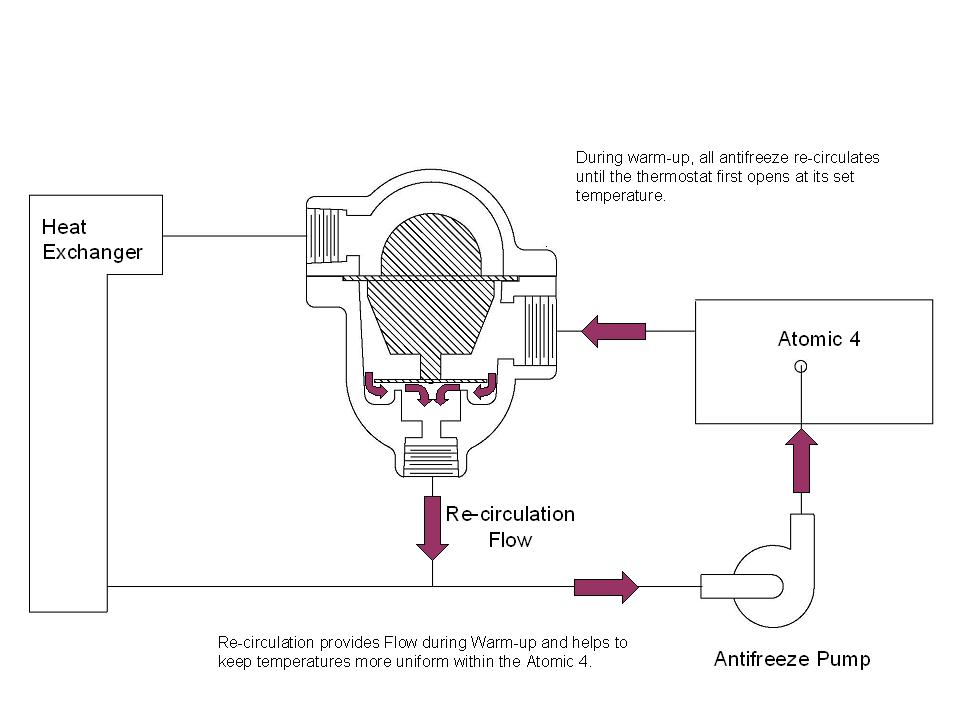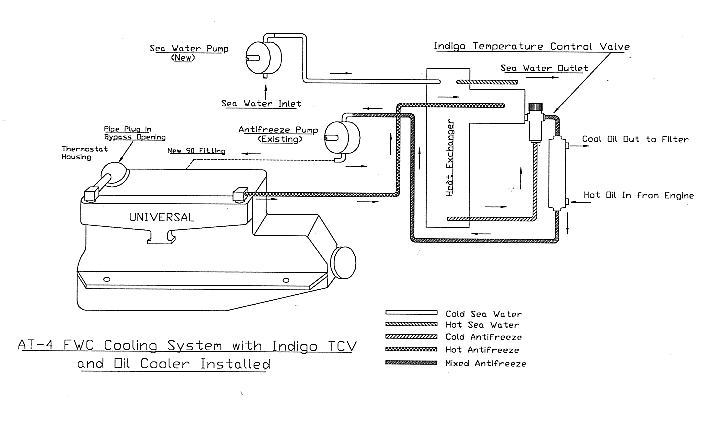Depending on the type of heat exchanger there may be a cover plate on one end. Opening it will expose the tube bundle inside where you can give it the ole' roto-rooter treatment (figuratively of course).
No cooling water moving through engine
Collapse
X
-
Usually, heat-exchangers have disc-shaped end-caps that are removable for cleaning. Certainly the vertical style HX sold here does. It's held on with a single gasketed bolt in the center.

I'm not familiar with the horizontal ones, but I would assume they would too.
EDIT: Neil types faster than I do!@(^.^)@ Ed
1977 Pearson P-323 "Dolce Vita"
with rebuilt Atomic-4
sigpic
Comment
-
-
I can't remember ever seeing a heat exchanger that didn't have a removable cover plate. It was safer for me to leave an editorial escape route in my previous post in case someone here has the only HX in existence without one.Neil
1977 Catalina 30
San Pedro, California
prior boats 1987 Westsail 32, 1970 Catalina 22
Had my hands in a few others
Comment
-
-
Edward and Neil
It does have a cap on at least one held on by a bolt through the middle and possibly on both ends. It really looks just like the photo you showed Edward. Tomorrow I will try and remove the heat exchanger and open it up. Has anyone else ever cleaned one before?
David
Comment
-
-
Can you tell us where all those hoses go? It seems like an oddity but who knows, it may be an innovation some of us haven't seen before.Originally posted by RIDAVIDK View PostI meant to ask also. Does anyone have any ideas on the purpose of the "mixing valve" that is attached to the heat exchanger in the photo?Neil
1977 Catalina 30
San Pedro, California
prior boats 1987 Westsail 32, 1970 Catalina 22
Had my hands in a few others
Comment
-
-
Long ago, I remember seeing something like this. I believe it is an adjustable external thermostat/recirculating valve. IIRC, it was marketed as an add-on for late-model engines to return to the early-model type of temperature regulation, with part of the hot coolant recirculated back to the intake.
The advantage was supposed to be more rapid warm-up. This was especially useful for installations that included a hot-water heater for washing and showers.
Indigo sells a modern version of this, but it is not adjustable. Here's a link to the plumbing for that system:
EDIT: I did some more research, and I believe it is Indigo's older Temperature Control Valve (TCV), as shown in this diagram (which also includes an oil cooler):
Last edited by edwardc; 05-07-2013, 08:18 PM.@(^.^)@ Ed
1977 Pearson P-323 "Dolce Vita"
with rebuilt Atomic-4
sigpic
Comment
-
-
Edward
That is great info. I guess my concern is that something has possibly gone wrong with the valve and it is blocking water flow to the exhaust. My plan will be to remove and clean the heat exchanger and see if that clears things up, and if not, then by-pass the TCV valve and see if that solves it. After that I might be out of ideas.
David
Comment
-
-
David,
Before you start hauling things apart I'd like to suggest that you get some pics with a digital camera. Resize them to about 800 pixels and post them on the forum here. I wouldn't pull the heat exchanger just yet ...
Lets see what has been done there plumbing wise. I'd be checking everything else there. Might also have to that T-stat or whatever it is...by pass it and see what happens.
Pictures will help allot.Mo
"Odyssey"
1976 C&C 30 MKI
The pessimist complains about the wind.
The optimist expects it to change.
The realist adjusts the sails.
...Sir William Arthur Ward.
Comment
-
-
The TCV controls the flow of anti-freeze coolant, not the raw water. The raw water path is pretty simple. Since you have already confirmed that the raw water path is clear to the HX inlet, the next step is to reconnect it and disconnect the hose from the HX raw water outlet. If there's no flow out, the HX is clogged.Originally posted by RIDAVIDK View PostEdward
That is great info. I guess my concern is that something has possibly gone wrong with the valve and it is blocking water flow to the exhaust. My plan will be to remove and clean the heat exchanger and see if that clears things up, and if not, then by-pass the TCV valve and see if that solves it. After that I might be out of ideas.
David
I'd say this is likely. One of the two picture links you posted shows a bit of corrosion around the HX top plate, and the zinc and bottom plate, Indicating that they've been weeping for some time without maintenance.
If the HX turns out not be the problem, the next thing downstream is the water injection point. These can become clogged with salt crystals, corrosion, and other crud.Last edited by edwardc; 05-07-2013, 09:52 PM.@(^.^)@ Ed
1977 Pearson P-323 "Dolce Vita"
with rebuilt Atomic-4
sigpic
Comment
-
-
Edward,Originally posted by edwardc View PostThe TCV controls the flow of anti-freeze coolant, not the raw water. The raw water path is pretty simple. Since you have already confirmed that the raw water path is clear to the HX inlet, the next step is to reconnect it and disconnect the hose from the HX raw water outlet. If there's no flow out, the HX is clogged.
I'd say this is likely. One of the two picture links you posted shows a bit of corrosion around the HX top plate, and the zinc and bottom plate, Indicating that they've been weeping for some time without maintenance.
If the HX turns out not be the problem, the next thing downstream is the water injection point. These can become clogged with salt crystals, corrosion, and other crud.
Makes sense.Mo
"Odyssey"
1976 C&C 30 MKI
The pessimist complains about the wind.
The optimist expects it to change.
The realist adjusts the sails.
...Sir William Arthur Ward.
Comment
-
-
Testing, testing...
Welcome to the forum David.
Since the boat is on the hard and your just interested in running the motor for evaluation purposes, would it make sense to completely bypass the FWC system completely for the time being?
All that other stuff is nice but not the critical concern at this point.
I can tell just by following along that whatever boat you end up with is going to be a well taken care of boat..
Good luck..Mike, Slower-Lower Eastern shore, MD
1973 Pearson 33
1967 Bristol 27
sigpic
Comment
-
-
A good day
Hi Everyone
SUCCESS!! I removed the heat exchanger from the boat and then took off the two end caps to gain access to the innards. The fresh water side that had anti-freeze in it was completely clear. The sea water side was fairly clear on the top, but every hole on the bottom was completely plugged with what looked like a gray, sandy material. There was also a couple of pieces of the anode, broken off and laying in the bottom. I used a welding rod and was able to poke holes through the hardened material. Once I had cleaned most of it out, I put the end cap back on and used some bottom cleaning liquid the guy at the yard had, and let it soak in that. I did the same for the top end. I rinsed it thoroughly with a lot of water and it flowed freely throughout. I then re-installed it in the boat, hooked up all the hoses, and filled the system with plain water. The moment of truth. I started the engine with the inlet hose in a pail of water, and it sucked it up like a champ, spitting it out the transom exhaust. I was short on time, so that was all I could do today. I plan on going back on Friday and running the engine for a longer period to make sure all is well with the whole system.
Thanks to everyone for your advice and help.
David
Comment
-



Comment